
Messier 109 is a barred spiral galaxy exhibiting a weak inner ring structure around the central bar approximately 67.2 ± 23 million light-years away in the northern constellation Ursa Major. M109 can be seen south-east of the star Phecda.
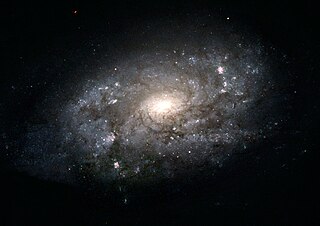
NGC 3949 is an unbarred spiral galaxy in the constellation Ursa Major, approximately 50 million light-years away from the Earth. It was discovered by German-British astronomer William Herschel on 5 February 1788.

NGC 4088 is an intermediate spiral galaxy in the constellation Ursa Major. The galaxy forms a physical pair with NGC 4085, which is located 11′ away.

NGC 3953 is a barred spiral galaxy located in the constellation Ursa Major. It was discovered by Pierre Méchain on 12 March 1781. The galaxy is known to exhibit an inner ring structure that encircles the bar. NGC 3953 is a member of the M109 Group, a large group of galaxies located within the constellation Ursa Major that may contain over 50 galaxies.

NGC 5144 is an unbarred spiral galaxy located in the constellation of Ursa Minor. It has a velocity of 3,202 ± 9 km/s corresponding to a Hubble Distance of 47.2 ± 3.3 megaparsecs. It was discovered by William Herschel in May 1791.

NGC 3938 is an unbarred spiral galaxy in the Ursa Major constellation. It was discovered on 6 February 1788 by William Herschel. It is one of the brightest spiral galaxies in the Ursa Major South galaxy group and is roughly 67,000 light years in diameter. It is approximately 43 million light years away from Earth. NGC 3938 is classified as type Sc under the Hubble sequence, a loosely wound spiral galaxy with a smaller and dimmer bulge. The spiral arms of the galaxy contain many areas of ionized atomic hydrogen gas, more so towards the center.

NGC 3718, also called Arp 214, is a galaxy located approximately 52 million light years from Earth in the constellation Ursa Major. It is either a lenticular or spiral galaxy.

NGC 7038 is an intermediate spiral galaxy located about 210 million light-years away in the constellation of Indus. Astronomer John Herschel discovered NGC 7038 on September 30, 1834.

NGC 7083 is an unbarred spiral galaxy located about 134 million light-years away in the constellation of Indus. It is also classified as a flocculent spiral galaxy. NGC 7083 was discovered by astronomer James Dunlop on August 28, 1826.

NGC 4907 is a barred spiral galaxy located about 270 million light-years away in the constellation of Coma Berenices. It is also classified as a LINER galaxy. NGC 4907 was discovered by astronomer Heinrich d'Arrest on May 5, 1864. The galaxy is a member of the Coma Cluster, located equidistant between NGC 4928 and NGC 4829.

NGC 3285 is a barred spiral galaxy located about 200 million light-years away in the constellation Hydra. The galaxy was discovered by astronomer John Herschel on March 24, 1835. NGC 3285 is a member of the Hydra Cluster.
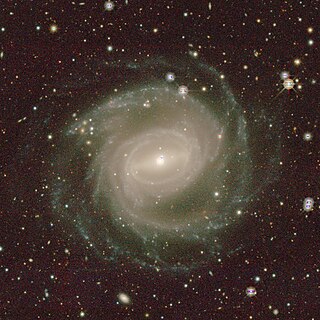
NGC 3313 is a large barred spiral galaxy located about 55 megaparsecs away in the constellation Hydra. It was discovered by astronomer Ormond Stone in 1886 and is an outlying member of the Hydra Cluster.
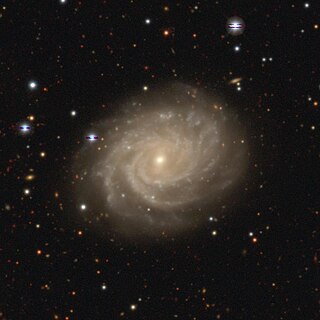
NGC 3336 is a barred spiral galaxy located about 190 million light-years away in the constellation Hydra. It was discovered by astronomer John Herschel on March 24, 1835. NGC 3336 is a member of the Hydra Cluster.

NGC 1264 is a low-surface-brightness barred spiral galaxy located about 145 million light-years away in the constellation Perseus. The galaxy was discovered by astronomer Guillaume Bigourdan on October 19, 1884. NGC 1264 is a member of the Perseus Cluster.

NGC 3928, also known as the Miniature Spiral, is a lenticular galaxy, sometimes classified as a dwarf spiral galaxy, in the constellation Ursa Major. It was discovered by William Herschel on March 9, 1788.
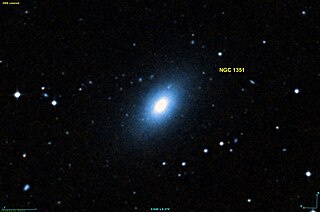
NGC 1351 is a lenticular galaxy in the constellation Fornax. It has a redshift of z=0.00505, and its distance from Earth can be estimated as 21 million parsecs. It is elongated in shape, and was discovered by John Herschel on October 19, 1835.

NGC 2606 is a spiral galaxy located around 646 million light-years away in the constellation Ursa Major. NGC 2606 was discovered on February 16th, 1831 by the astronomer John Herschel, and it has a diameter around 232,000 light-years. NGC 2606 is known to have some star-formation, and it is known to have an active galactic nucleus, specifically a Type II Seyfert galaxy.

NGC 2688 is a spiral galaxy located in Ursa Major. It is located 758 million light-years away from the Solar System and is moving away at a speed of 15,190 km/s. NGC 2688 was found by R.J. Mitchell who was an Irish astronomer and assistant to William Parsons. When Mitchell first saw the object, he commented it as very small and faint. According to Professor Seligman, the galaxy is classified as a lenticular galaxy rather than a spiral galaxy.
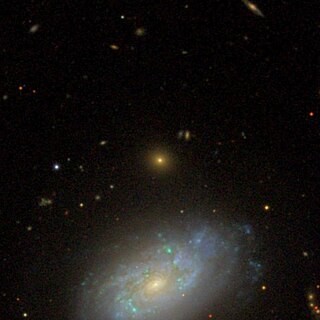
NGC 3950 is an elliptical galaxy of type E, in Ursa Major. Its redshift is 0.074602, meaning NGC 3950 is 1.03 billion light-years or 316 Mpc from Earth, which is within the Hubble distance values. This high redshift makes NGC 3950 one of the furthest New General Catalogue objects.

NGC 2692 is a spiral galaxy located around 188 million light-years away in the constellation Ursa Major. It was discovered on March 17, 1790, by astronomer William Herschel, and it has a diameter around 46,000 light-years. NGC 2692 is not known to have lots of star-formation, and it is not known to have an active galactic nucleus.




















